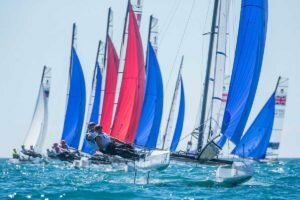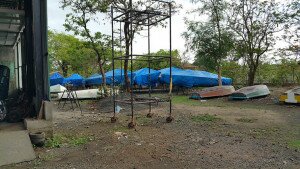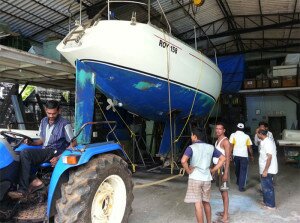Capt. Dinyar Pochkhanawala, a seagoing captain took the delivery of his new Seabird Mark3HF, named Rashna. Both he and his father Capt. Sam Pochkhanawala sail her regularly.
Here’s what he to say about the experience while sailing his new boat.
The Mark 3HF- Seabird class sail boat named Rashna, built by XS Marines, was delivered on 13th Dec 2014. She is sailed mostly with a team of 3 (the max capacity is 5).
The boat has proved to be nimbly and spirited in wind force ranging from 2 to 4. (Wind force currently experienced so far) Surprisingly in extremely light winds or lulls she will still make way albeit slowly (Ensure the main and jib is pulled in tight) this boat will virtually claw the edge of the wind. In a light breeze allow the boat to fall off the wind; enough to fill the sail and quickly luff up and one can get that extra push to get her going. Handling is good on all points of sail.
In the one occasion when she was sailed in nearly force 4, with the main sail not reefed (the wind later picked up closer to Sunk Rock) not once did the boat fall wildly off the wind. Yes, constant but limited weather helm was all that was required to check her. The CEF and CLR are well calculated and placed so as to ensure that only the right amount of weather helm be required and with 2 members of the 3 man team requiring to hike out. (Understandably, as the main sail was not reefed). South of Sunk Rock, she was gibed. This was done by first bringing her as close to a dead run and then the boat gibed. The gibe went of smoothly without any concern or worry of capsize proving that the Mark 3HF is well designed and hence a stable boat. When tacking, the sheet can be locked down in the cam cleat and the boat tacked without the sheet running loose after the boat has come round on her new course on the opposite tack. Rudder handling is good (Again this is owed to the boats well placed CEF and CLR).
There is ample of storage space in the side benches as well as in the forward end below the covered bow. The main sail leech telltales and jib telltales are correctly placed so as to provide for correct reading of attached/unattached flow.
Sail trim with the sheets is fluid allowing smooth running of the sheet through the main sheet block. No fouling of the sheet in the main sheet block. Tack or gibe and the block swivels well. The runners too are easy to handle.
I feel though that the tiller could be shortened a bit, say knock off about 8 inches at the forward end. I understand that this length was designed for positioning the helmsman during racing but a tiller extension will make up for this. The forward deck proved to be slippery (when I tried standing to take a few photos of the boat) even with a well designed pair of Sebago boat shoes. Also, on a run with the boom set out max, the main sail touches the after mast shroud. This should be looked into in the design of future boats.
In all, I have had a happy experience so far.








